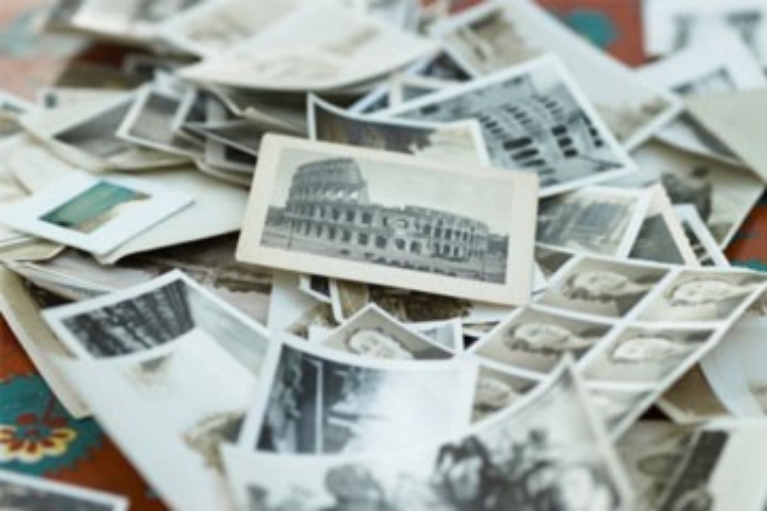A Terrific Article and advise from Alia Hoyt “How to Properly Store Really, Really Old Photos” 14 July 2010.
________________________________________
Your family’s photos are the window to your history. Keep them stored safely!
MICHAEL BLANN/THINKSTOCK
Don’t try to deny it. Somewhere in your house lurks a box of cracked, withered and faded photographs of your great-great-grandparents gazing stoically into the distance, imagining possibilities yet to be realized, like indoor plumbing and MP3 players. Why let these historically and emotionally significant photos waste away in the back of your closet? Take a few simple steps to save them from further deterioration. And while you’re at it, remember to make provisions for the more recently captured images in your collection.
Although photo restoration techniques have come a long way in recent years, you shouldn’t be lulled into a false sense of snapshot security. It’s far better to keep valuable or treasured photos in prime condition from the start, rather than taking a chance on fixing them up down the road. Not sure what the major threats are to the longevity of your photos? Find out on the next page — you might be surprised.
The Damage Culprits
What causes your treasured photos to become damaged in the first place? Obviously, the storage method (or lack thereof) plays a big role. A shoebox in your closet doesn’t count as a bonafide storage method. Photos are delicate by nature, and they should be protected like any other valuable. The older and more precious the photo is, the more care should be taken to curb damage by preventable elements, such as light, excessive heat or cold, bug infestations, fingerprints, water damage and mildew.
Sometimes, photo damage can be difficult to prevent. Poor processing by the developer in the first place can cause photos to be less resilient over time. Also, the materials utilized during development, like dyes, inks, chemicals and the gelatin surface of a photograph, can interact badly, resulting in fading or spotting. Photographic paper or mounting boards sometimes contain acid, which is known to cause long-term damage on delicate photos.
Ironically, even those of us with good intentions can do more harm than good by removing old photos from albums. Peeling back a photo from a sticky page can cause irreversible cracks that even the best restoration expert will have trouble fixing. The best bet in this situation is just to leave the photo alone and opt instead to store the album correctly.
Safe Storage Methods
Even photos you took last week will someday be really old, so invest in a proper storage system from the start! Your local craft store carries the basic supplies you’ll need. Stock up on albums with archival sleeves as well as acid-free photo storage boxes. Before filling and packing away any old photos, toss out paper clips, rubber bands, manila envelopes, staples and anything that has an odor. Wear cotton gloves while handling photographs to avoid long-term fingerprint damage.
Photos with historic significance should be treated extra carefully. In these cases, it’s usually best to seek the help of a professionally trained conservator, who can clean, treat and prepare the photos for storage in the most effective manner possible
Often, the environment is just as important as the storage container itself. The ideal storage environment for photographs is a dark location around 68 degrees Fahrenheit with 30 to 40 percent relative humidity, according to the Library of Congress. That said, don’t put boxes of photos in your attic or garage, as photos require an environment that isn’t overly hot, cold, humid or dry. Fireproof or flood-proof storage boxes are also available for storing valuable photos.
In addition to storing photos themselves, put original transparencies (negatives or slides) and digital copies in a safe place. Before you store old photos, you should consider making digital scans and copying the files onto CDs. Some CDs might not last too long, though, so be sure to pop them in your computer every few years to make sure they’re still working. Alternatively, you can load photos on a USB drive.
Above all, be sure to label your photos with the names of the people and places featured, as well as the date. You might remember your Great Aunt Mildred’s full name, but your grandchildren will thank you for writing down the specifics. Note the details on the back of the photo using a soft drawing pencil as ink can cause unnecessary damage.
Did You Know?
Do you prefer to look at a photo rather than pack it away? Experts caution against framing original photos because light can damage them over time. Frame a reproduced copy, and store the original photo in a safe place, or purchase a special frame with conservation glass and an acid-free mat and backing. Be sure to avoid wooden backing at all costs, since it can expose your photos to damaging chemicals.
Sources
• McKnight, Ralph G. “Guidelines for Preserving Your Photographic Heritage.” Photo Heritage. (Aug. 23, 2010). http://photoheritage.net/preserving.php#0.1_3
• Norris, Debbie Hess. “Caring for Your Photographic Collections.” April 18, 2007. (Aug. 23, 2010). http://www.mnhs.org/preserve/conservation/reports/photoqanda.pdf
• “Preservation.” Heritage Photographs. (Aug. 23, 2010). http://www.heritagephotos.com/preservation.html
• “Should I Remove My Photographs From Old Albums, Such As Black Paper Albums Or Self-Stick Albums?” The National Archives. (Aug. 23, 2010). http://www.archives.gov/preservation/family-archives/detaching-photos.html
• Wilson, Bonnie. “Ask an Expert: Preserving Your Photographs.” Minnesota Historical Society. March 1994. (Aug. 23, 2010). http://www.mnhs.org/preserve/conservation/reports/photoqanda.pdf
Contact Us here to know more.



Leave A Comment